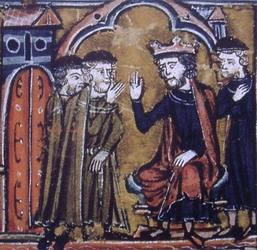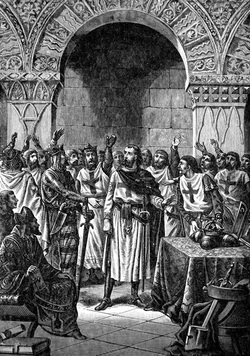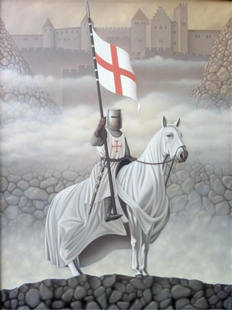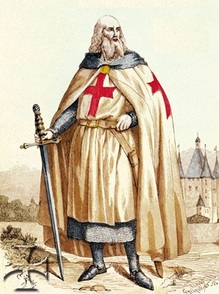A Brief History of the Knights Templar

Baldwin II
The Knights Templar were one of the earliest and most famous of the European Christian military orders. A society of knights whose mission, at least ostensibly, was to defend and further their religious faith. In 1118 A.D., nineteen years after the 1st Crusade, a French knight named Hugues de Payens and eight companions offered their services to the city’s Christian king, Baldwin II, and swore a vow to defend the city against any and all enemies. Baldwin provided the captured Al Aqsa Mosque, a building on Mount Moriah, the site of the former Temple of King Solomon. The Order had few financial resources and relied on donations to survive. Their emblem was of two knights riding on a single horse, emphasizing the Order's poverty.
These Poor Fellow Soldiers of Jesus Christ, as they termed themselves found an influential advocate; Bernard de Clairvaux. He spoke and wrote persuasively on their behalf, and in 1129 at the Council of Troyes, the Order was officially endorsed by the Church. With this formal blessing, the Templars became a favored charity throughout Christendom, receiving money, land, businesses, and noble-born sons from families who were eager to help with the fight in the Holy Land. Another major benefit came in 1139, when Pope Innocent II's papal bull Omne Datum Optimum exempted the Order from obedience to local laws. This ruling meant that the Templars could pass freely through all borders, were not required to pay any taxes, and were exempt from all authority except that of the Pope.
"A Templar Knight is truly a fearless knight, and secure on every side, for his soul is protected by the armour of faith, just as his body is protected by the armour of steel. He is thus doubly armed, and need fear neither demons nor men."— Bernard de Clairvaux, c. 1135
That is why, the knights called themselves Pauperes commilitones Christi Templique Solomonici — Latin for "The Poor Fellow-Soldiers of Christ and the Temple of Solomon"—which in time, was shortened to the Knights of the Temple and eventually Knights Templar or Templars.
These Poor Fellow Soldiers of Jesus Christ, as they termed themselves found an influential advocate; Bernard de Clairvaux. He spoke and wrote persuasively on their behalf, and in 1129 at the Council of Troyes, the Order was officially endorsed by the Church. With this formal blessing, the Templars became a favored charity throughout Christendom, receiving money, land, businesses, and noble-born sons from families who were eager to help with the fight in the Holy Land. Another major benefit came in 1139, when Pope Innocent II's papal bull Omne Datum Optimum exempted the Order from obedience to local laws. This ruling meant that the Templars could pass freely through all borders, were not required to pay any taxes, and were exempt from all authority except that of the Pope.
"A Templar Knight is truly a fearless knight, and secure on every side, for his soul is protected by the armour of faith, just as his body is protected by the armour of steel. He is thus doubly armed, and need fear neither demons nor men."— Bernard de Clairvaux, c. 1135
That is why, the knights called themselves Pauperes commilitones Christi Templique Solomonici — Latin for "The Poor Fellow-Soldiers of Christ and the Temple of Solomon"—which in time, was shortened to the Knights of the Temple and eventually Knights Templar or Templars.

Knights Templar became laymen who protected and defended Christians traveling to Jerusalem. These men took vows of poverty, chastity and obedience, and were renowned for their fierceness and courage in battle. Over the next two centuries, the Templars grew into one of the most powerful organizations in the medieval world. Their warriors, who wore over their armor distinctive white mantles emblazoned with a red cross, developed a reputation for their fighting prowess, discipline and tenacity. They generally fought fiercely, in keeping with the Order’s rule that the warriors should never surrender unless the Templar flag had fallen, and even then they were first to try to regroup. (The order also had a policy of not paying ransom for members captured in battle.) According to the 1911 edition of the Catholic Encyclopedia, some 20,000 Templar soldiers gave their lives in battle against Muslim forces over the course of the order’s existence.

This was the era of chivalric ascendancy. Much as outstanding athletes receive the hero worship and admiration of the public today, so did those Knights of old capture the hearts and the wealth of the public of their period. Their fame spread like wildfire. Rulers hastened to be identified with Knights Templar and to present gold and property to the Order. In time, the Templars became a tremendous political and economic power as well. Various Popes rewarded the Templars by ordering that they be exempted from all taxation and even the customary tithing to support the Church itself. The order gradually gained numerous non-warrior members throughout Europe, who leveraged its burgeoning treasury to acquire land and buildings and to create a financial empire that functioned as one of the first European banking systems. They advised Christian and Muslim leaders alike and were often questioned, in their day, for their tolerance and openness to various faiths.

Jacques de Molay
It is a matter of history that the warriors who fought for Christianity as Knights Templar had their vicissitudes with more downs than ups on the battlefield through the centuries. However, their wealth and their prestige remained undiminished. On the contrary their treasury became too large to escape the notice of some financially embarrassed rulers, especially Philip the Fair, King of France.
In the early 1300s, Philip who had borrowed heavily from the Templars, decided to avoid having to pay back his debt by destroying the order. Philip successfully pressured Pope Clement V, a Frenchman whom the Catholic Encyclopedia describes as "of weak character and easily deceived," to persecute the Templars on trumped-up charges of heresy and sacrileges, such as spitting on the Crucifix. On Friday, October 13, 1307 (a date linked with the origin of the Friday the 13th superstition)), the French king issued secret orders for all the members of the Order in his country to be arrested on the same day, and many were tortured and put to death. The Templars were charged with numerous offenses (including apostasy, idolatry, heresy, obscene rituals and homosexuality, financial corruption and fraud, and secrecy). Many of the accused confessed to these charges under torture, and these confessions, even though obtained under duress, caused a scandal in Paris.
Clement officially disbanded the Templars in 1312. The following year, the Templars' Grand Master, Jacques de Molay, dramatically recanted his confession as he was about to be hung in front of Notre Dame in Paris. Philip then ordered him to be taken to the Isle de la Cite, where he was burned at the stake. According to legend, he called out from the flames that both Pope Clement and King Philip would soon meet him before God. Pope Clement died only a month later, and King Philip died in a hunting accident before the end of the year.
Some have written that after the death of Grand Master DeMolay there was an unbroken succession of the Grand Masters and a constant Templar organization without a lapse. This is difficult to believe and it is even more difficult to read the many treatises written to support or disprove the theory.
With their military mission and extensive financial resources, the Knights Templar funded a large number of building projects around Europe and the Holy Land. Many of these structures are still standing. Many sites also maintain the name "Temple" because of centuries-old association with the Templars.
To simplify the story without attempting to elaborate or quote various researchers, all we know is that when Templary emerged in the early 1700's it was a part of Freemasonry. THERE IS NO PROOF OF DIRECT CONNECTION BETWEEN THE ANCIENT ORDER AND THE MODERN ORDER KNOWN TO DAY AS THE KNIGHTS TEMPLAR.
However, a few facts: Speculative Freemasonry first appeared in Scotland. The Templars had lands in Scotland since 1128, most notably Balentrodach, by bequest of David I, and known today as 'Temple'. This location is but 7 miles from Roslin Chapel just outside of Edinburgh. With the disbandment of the Templars in 1314 the lands fell under the protection of the Saint Clairs of Roslin.
William Saint-Clair of Roslin was elected as ‘Hereditary Grand Master Mason of Scotland’ by several stonemason lodges in 1602.
In the early 1300s, Philip who had borrowed heavily from the Templars, decided to avoid having to pay back his debt by destroying the order. Philip successfully pressured Pope Clement V, a Frenchman whom the Catholic Encyclopedia describes as "of weak character and easily deceived," to persecute the Templars on trumped-up charges of heresy and sacrileges, such as spitting on the Crucifix. On Friday, October 13, 1307 (a date linked with the origin of the Friday the 13th superstition)), the French king issued secret orders for all the members of the Order in his country to be arrested on the same day, and many were tortured and put to death. The Templars were charged with numerous offenses (including apostasy, idolatry, heresy, obscene rituals and homosexuality, financial corruption and fraud, and secrecy). Many of the accused confessed to these charges under torture, and these confessions, even though obtained under duress, caused a scandal in Paris.
Clement officially disbanded the Templars in 1312. The following year, the Templars' Grand Master, Jacques de Molay, dramatically recanted his confession as he was about to be hung in front of Notre Dame in Paris. Philip then ordered him to be taken to the Isle de la Cite, where he was burned at the stake. According to legend, he called out from the flames that both Pope Clement and King Philip would soon meet him before God. Pope Clement died only a month later, and King Philip died in a hunting accident before the end of the year.
Some have written that after the death of Grand Master DeMolay there was an unbroken succession of the Grand Masters and a constant Templar organization without a lapse. This is difficult to believe and it is even more difficult to read the many treatises written to support or disprove the theory.
With their military mission and extensive financial resources, the Knights Templar funded a large number of building projects around Europe and the Holy Land. Many of these structures are still standing. Many sites also maintain the name "Temple" because of centuries-old association with the Templars.
To simplify the story without attempting to elaborate or quote various researchers, all we know is that when Templary emerged in the early 1700's it was a part of Freemasonry. THERE IS NO PROOF OF DIRECT CONNECTION BETWEEN THE ANCIENT ORDER AND THE MODERN ORDER KNOWN TO DAY AS THE KNIGHTS TEMPLAR.
However, a few facts: Speculative Freemasonry first appeared in Scotland. The Templars had lands in Scotland since 1128, most notably Balentrodach, by bequest of David I, and known today as 'Temple'. This location is but 7 miles from Roslin Chapel just outside of Edinburgh. With the disbandment of the Templars in 1314 the lands fell under the protection of the Saint Clairs of Roslin.
William Saint-Clair of Roslin was elected as ‘Hereditary Grand Master Mason of Scotland’ by several stonemason lodges in 1602.
